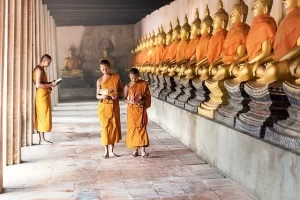Unique Blend as a Cultural Phenomenon - Japan's Fusion of Tradition and Modernity
Japan’s Fusion of Tradition and Modernity is vividly showcased as you walk through the streets of this captivating country. One can’t help but marvel at the harmonious blend of traditions seamlessly entwined with innovative technologies and modern architecture. Japan, with its pulsating neon city lights and tranquil tea ceremonies, presents a fascinating fusion of tradition and modernity.
So, what makes Japan’s blend unique? Unlike other countries, where progress may shoulder aside the old, Japan has managed to cherish its cultural heritage while forging ahead in the techno-futuristic world. Let’s delve into the captivating duality of this remarkable nation and explore the fascinating truths that will inform and inspire.
The Ancestral Pillars: Rooted in Tradition
In historic Japan, with its rich traditions, resilience has persevered over the years. Elaborate tea ceremonies, time-honored sumo wrestling rituals, and venerable Buddhist customs define the
country’s cultural authenticity. These are not just relics of the past but are deeply ingrained into the daily lives of the Japanese, profoundly influencing societal norms and values. The tea ceremony, for instance, goes beyond just the act of drinking tea; it also highlights the importance of mindfulness, harmony,
and respect.
Embracing Progress: Japan's Stride into Modenity
Despite its deep-seated traditions, Japan has rapidly advanced into the 21st century. The country now stands alongside global leaders in technology, boasting renowned companies such as Sony, Toyota, and Panasonic. The ultramodern Tokyo skyline, featuring iconic structures like the Tokyo Tower, serves as a remarkable display of Japan’s architectural expertise. These advancements have not only stimulated Japan’s economy but have also revolutionized societal perspectives and interactions.
Melding the Old and New: Japan's Harmonious Fusion
In Japan, the old and the new don’t just coexist – they harmonize. Take the city of Kyoto, for example, where thousand-year-old Shinto shrines protrude amidst ultra-modern high-rises! This balancing act between and progress offers a living testament to Japan’s dynamic cultural identity. Other nations can glean valuable lessons from how Japan has preserved its cultural integrity amid rapid advancement.
Challenges and Opportunities in Japan's Cultural Fusion
This union of the old and the new poses challenges. Balancing the preservation of cultural identity with the embrace of modernity is a difficult task. However, Japan’s cultural fusion also brings opportunities, allowing this nation to showcase a unique aspect of global tourism, enhance intercultural understanding, and shape a distinctive global brand. Looking ahead, it appears that Japan’s cultural blend will continue to flourish, creating an intriguing vision for the future.
Conclusion - Japan's Fusion of Tradition and Modernity
In summary, Japan’s ability to balance tradition and modernity is truly remarkable from a cultural perspective. It is not merely a matter of coexistence, but rather a harmonious symphony that pays homage to its historical origins while also enthusiastically embracing future potential. By unraveling this captivating fusion, we gain a greater appreciation for Japan’s distinctiveness. Therefore, why not delve deeper and embark on a personal exploration of Japan’s captivating cultural blend?
Frequently Asked Questions: Japan's Fusion of Tradition and Modernity
You may still question about Japan’s unique blend of tradition and modernity. Here are some common queries:
Why is Japan’s blend of tradition and modernity unique?
Japan’s blend is unique because it harmonizes the old and the new, rather than just having them co. This results in a cultural identity that sets Japan.
How traditions shape Japanese society
Traditions deeply influence norms and values. For example, the harmony and respect of the tea ceremony are in Japanese societal interactions.
What challenges are in blending tradition and modern?
Challenges arise in preserving culture while also keeping up with it. Striking a balance between the two requires continuous effort and understanding.
What opportunities does this blend present?
This blend offers unique opportunities, such as showcasing a distinct global brand, fostering intercultural understanding, and diversifying tourism.
What is the future trajectory of this blend?
It is expected that Japan will continue to thrive on its cultural fusion, navigating any challenges that arise while reaping the benefits. The future looks promising indeed!







